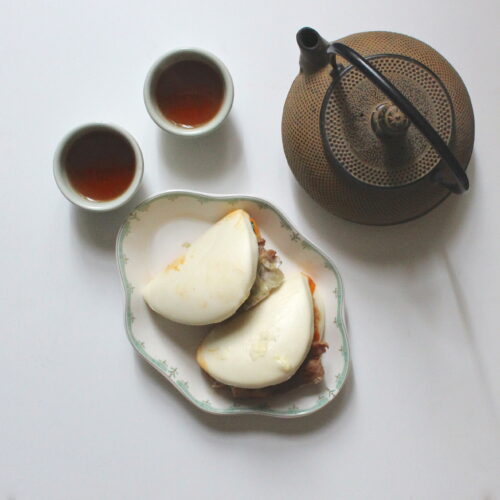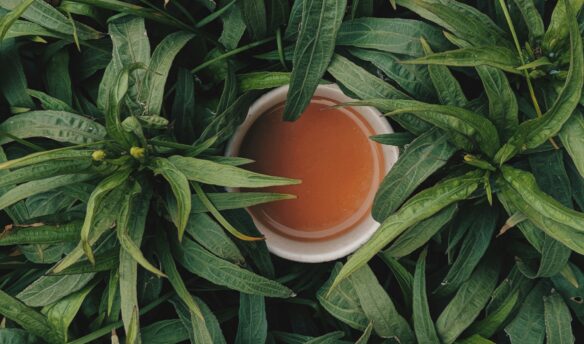[D]im sum, a feast featuring a series of small plates, is commonly paired with Chinese New Year festivities, but is often enjoyed year-round on weekends. Dim sum service featuring rolling carts carrying petite plate shares quite a bond with the act of sipping steeped tea. In fact, dim sum dining is linked to the older Cantonese tradition yum cha which translates to drink tea. Historical documents note that teahouses were established along the ancient Silk Road as a place for travelers to rest, where they would seek sustenance after long journeys with small plates served with tea. Traditional dim sum dishes of steamed buns, dumplings, and rice noodle rolls (stuffed with a range of fillings) are quite delectable but can weigh us down (and we can’t forget about the rich sweets, like egg custard tarts). The heavy flavors, fats, and oils are savored and then soothed with pots of pu-erh tea.
Steeping pu-erh several times allows us to linger at the table and bask in the glow of any good meal.
A tea category all its own, pu-erh is rooted in the Yunnan province of China. The leaves are sun dried and then aged via natural fermentation to develop a complex yet mellow flavor. Within this tea category there are two styles to reference, sheng (green or raw) and shu (ripe or cooked, which is brown or black in color). Sheng pu-erh consists of minimally processed leaves carefully aged for a substantial amount of time. With shu pu-erh, moisture and heat are added during the fermentation process, which allows the complexity to mature much faster and in turn offers deeper flavors. Like other teas, pu-erh teas are sold as loose leaves but will often be compressed into bricks, discs, or mushroom shapes, among other presentations. (If you add a compressed pu-erh tea to your collection, do note that you will need to shave pieces of the tea off when ready to steep.) Pu-erhs are among the teas that we can steep repeatedly.
This smooth and mellow tea carries an array of complex flavors depending on the age of the tea, with tastes of warm, worn elegance that are akin to a fine cigar or aged whisky. Some pu-erhs can steep to reveal savory and often brothy earthiness that can be balanced by a subtle sweetness. Pu-erh’s complexities often make you stop and consider its journey (if it has been substantially aged), as the depth of flavor offers a certain wisdom that makes it the obvious choice for the dim sum meal that is rooted in an ancient Chinese celebration. Tony Gebely of The Phoenix Collection, a tea purveyor in California, recommends pairing the dim sum meal with shu pu-erhs, as they “are best for relaxing my stomach and making me feel less bloated.” In particular, he likes to pair “a dark steeping of camel’s breath tuocha,” as it is a “great companion to a deliciously heavy and greasy meal.” The silky smooth mouthfeel of the pu-erh seems to wash the lingering dim sum oils and heavy flavors away to cleanse the palate, while not straying too far from the savory flavors of the meal.
Beyond Chinese favorites, pu-erh can be paired with any rich or lengthy meal. You may even experience a sip of pu-erh blended with chrysanthemum flowers, as chrysanthemum is said to help cool the body, and, of course, steeping pu-erh several times allows us to linger at the table and bask in the glow of any good meal. Whether at the kitchen table or tucked into a tiny café that serves decadent baked goods, linger by a teapot of the earthy brew to balance rich bites and soothe gray winter days. Consider pu-erh to be a welcome, warm blanket draped over you after you’ve been sated and can’t quite move, one that also comforts you enough to leave the meal lighter and slightly more energized than when you arrived.
—Alexis Siemons is a tea consultant and writer. She blogs about her steeped adventures at teaspoonsandpetals.com.

















